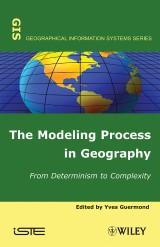Details

The Modeling Process in Geography
From Determinism to Complexity1. Aufl.
|
160,99 € |
|
| Verlag: | Wiley |
| Format: | EPUB |
| Veröffentl.: | 01.03.2013 |
| ISBN/EAN: | 9781118622575 |
| Sprache: | englisch |
| Anzahl Seiten: | 376 |
DRM-geschütztes eBook, Sie benötigen z.B. Adobe Digital Editions und eine Adobe ID zum Lesen.
Beschreibungen
<p>This title focuses on the evolution of the modeling process and on new research perspectives in theoretical and applied geography, as well as spatial planning. In the last 50 years, the achievements of spatial analysis models opened the way to a new understanding of the relationship between society and geographical space. In this book, these models are confronted by the real conditions of territorial prospect, regional dynamism, cultural policy, HMO, and spatial segregation. This confrontation takes into account the instability of social behavior and the permanence of partial determinist trajectories.</p>
<p>Foreword. The Taste for Measuring and Modeling xi<br /> Nicole MATHIEU</p> <p>Preface xxiii</p> <p>Acknowledgements xxv</p> <p><b>Chapter 1. The Place of Both the Model and Modeling in HSS 1</b><br /> <i>Patrice LANGLOIS and Daniel REGUER</i></p> <p>1.1. Models and modeling: definitions 2</p> <p>1.2. The mathematical concept of a model 5</p> <p>1.3. Is there a specificity of HSS? 7</p> <p>1.4. Modeling: explain to understand? 11</p> <p>1.5. Bibliography 13</p> <p><b>Chapter 2. From Classic Models to Incremental Models 15</b><br /> <i>Yves GUERMOND</i></p> <p>2.1. The geographic “object” 16</p> <p>2.2. Lessons from the “classic models” 16</p> <p>2.3. Introduction to dynamics and auto-organization 22</p> <p>2.4. From auto-organization to complexity 26</p> <p>2.5. Spatial agents 30</p> <p>2.6. Incremental modeling 32</p> <p>2.7. Bibliography 35</p> <p><b>Chapter 3. The Formalization of Knowledge in a Reality Simplifying System 39</b><br /> <i>Françoise LUCCHINI</i></p> <p>3.1. Formalizing a complex cultural system using a series of perspectives 40</p> <p>3.2. Differentiation of the system of cities by culture: contribution of the spatial analysis for testing the“global cultural model” 51</p> <p>3.3. Alternative formalizations 63</p> <p>3.4. Conclusion 69</p> <p>3.5. Bibliography 69</p> <p><b>Chapter 4. Modeling and Territorial Forecasting: Issues at Stake in the Modeling of Réunion’s Spatial System 71</b><br /> <i>Gilles LAJOIE</i></p> <p>4.1. Introduction 71</p> <p>4.2. A few major theoretical breakthroughs for modeling spatial complexity 72</p> <p>4.3. Modeling and territorial forecasting of the socio-spatial system of Réunion 78</p> <p>4.4. Modeling of Réunion’s socio-spatial system 90</p> <p>4.5. Towards a modeling of the dynamics of Réunion’s system 93</p> <p>4.6. Conclusion 97</p> <p>4.7. Bibliography 98</p> <p><b>Chapter 5. One Model May Conceal Another: Models of Health Geographies 101</b><br /> <i>Alain VAGUET</i></p> <p>5.1. Modeling in order to surpass descriptions? 102</p> <p>5.2. Mode of the models and models in vogue 104</p> <p>5.3. Conclusion 111</p> <p>5.4. Bibliography 111</p> <p><b>Chapter 6. Operational Models in HMO 113</b><br /> <i>Jean-François MARY and Jean-Manuel TOUSSAINT</i></p> <p>6.1. Buffer and barycenter to determine the location of cardiac defibrillation 114</p> <p>6.2. Thiessen’s accessibility formula 117</p> <p>6.3. Accessibility: the direct added-value of the GIS 121</p> <p>6.4. A regional database of road accessibility devoted to emergency 123</p> <p>6.5. The reallocation projects and their consequences 126</p> <p>6.6. Relocation of a medical clinic: simulation of a new accessibility 131</p> <p>6.7. Bibliography 134</p> <p><b>Chapter 7. Modeling Spatial Logics of Individual Behaviors: From Methodological Environmentalism to the Individual Resident Strategist 137</b><br /> <i>Michel BUSSI</i></p> <p>7.1. Reconsidering spatial determinism: modeling versus local development 138</p> <p>7.2. Ecological methodology 142</p> <p>7.3. Towards a post-industrialist behavior 149</p> <p>7.4. From neighborhood effect to the theory of the citizen-resident-strategist 152</p> <p>7.5. Bibliography 157</p> <p><b>Chapter 8. Temporalities and Modeling of Regional Dynamics: The Case of the European Union 161</b><br /> <i>Bernard ELISSALDE</i></p> <p>8.1. Integrating time and temporalities into spatial models 162</p> <p>8.2. Introduction of complexity theory in the interpretation of regional inequalities in Europe 168</p> <p>8.3. Conclusion 186</p> <p>8.4. Bibliography 188</p> <p><b>Chapter 9. Modeling the Watershed as a Complex Spatial System: A Review 191</b><br /> <i>Daniel DELAHAYE</i></p> <p>9.1. Shape indices for measuring various forms of a watershed 192</p> <p>9.2. Organization of the networks 193</p> <p>9.3. Synthesis concerning the shape and organization indices 200</p> <p>9.4. From morphometry to complex systems 202</p> <p>9.5. Conclusion 213</p> <p>9.6. Bibliography 213</p> <p><b>Chapter 10. Understanding to Measure...or Measuring to Understand? HBDS: Towards a Conceptual Approach for the Geographic Modeling of the Real World 217</b><br /> <i>Thierry SAINT-GERAND</i></p> <p>10.1. A forgotten face of the geographic approach 217</p> <p>10.2. Formalizing a spatial reasoning in databases 226</p> <p>10.3. Example of thematic application: the industrial risks at Notre- Dame-de-Gravenchon (lower Seine<br /> valley) 246</p> <p>10.4. Back to the sources 252</p> <p>10.5. Bibliography 253</p> <p><b>Chapter 11. Complexity and Spatial Systems 255</b><br /> <i>Patrice LANGLOIS</i></p> <p>11.1 The paradigm of complexity 255</p> <p>11.2. The systemic paradigm: from the combinatorial to emergence 260</p> <p>11.3. Moving towards a more formalized definition of the notion of a spatial system 266</p> <p>11.4. Bibliography 275</p> <p><b>Chapter 12. Cellular Automata for Modeling Spatial Systems 277</b><br /> <i>Patrice LANGLOIS</i></p> <p>12.1. The concept of the automaton and its modeling 277</p> <p>12.2. A little bit of history 278</p> <p>12.3. The concept of the finite state automaton 279</p> <p>12.4. The concept of the cellular automaton 285</p> <p>12.5. CAs used for geographic modeling 293</p> <p>12.6. Bibliography 306</p> <p>12.7. Websites 307</p> <p><b>Chapter 13. Multi-Agent Systems for Simulation in Geography: Moving Towards an Artificial Geography 309</b><br /> <i>Eric DAUDE</i></p> <p>13.1. Introduction 309</p> <p>13.2. From global to local description of structures and spatial dynamics 310</p> <p>13.3. Multi-agent systems 313</p> <p>13.4. Artificial geography: simulations of structures and spatial dynamics 319</p> <p>13.5. Conclusion 329</p> <p>13.6. Bibliography 329</p> <p><b>Conclusion 335</b><br /> <i>Yves GUERMOND</i></p> <p>List of Authors 337</p> <p>Index 339</p>
<p><strong>Yves Guermond</strong> is Emeritus Professor at the University of Rouen, France.

















